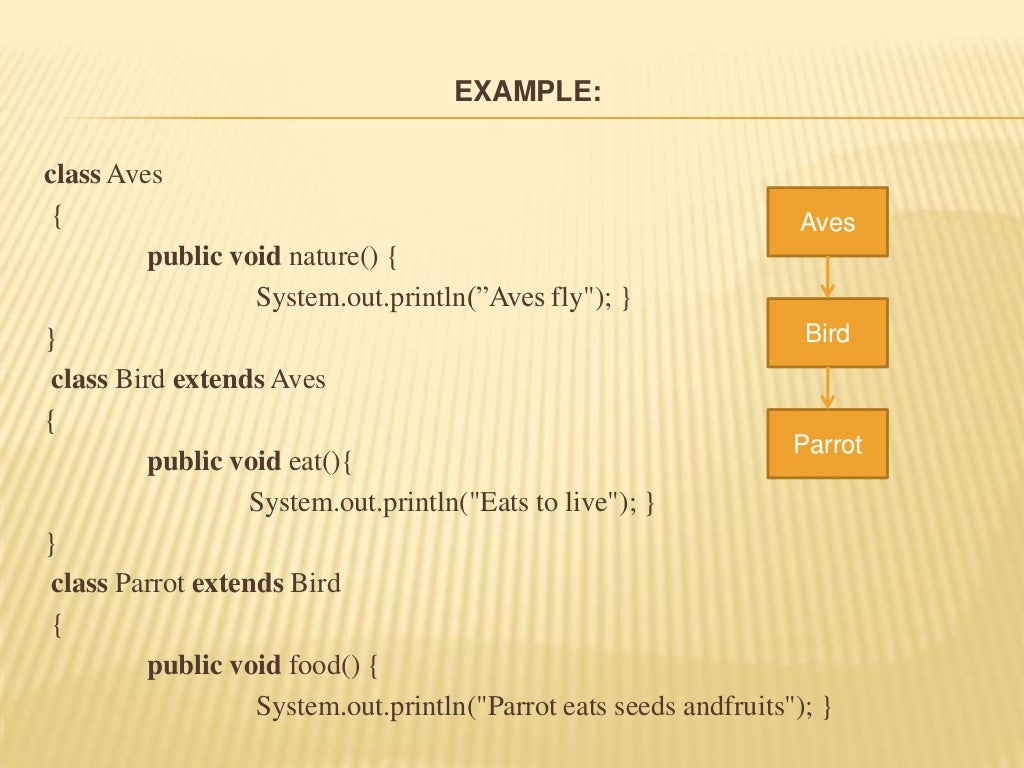
It happens because there is a super() attached to every no argument and default constructor call. Notice that the constructor of the Vehicle class is also called the Motorcycle constructor. When we create an object of Motorcycle using the new keyword, the class’ constructor is called. We print a message like the Vehicle constructor in the Motorcycle class. If a class do not have any constructor then default constructor. The Motorcycle class inherits the Vehicle using the extends keyword, making Vehicle a superclass and Motorcycle a subclass. When we inherit class into another class then object of base class is initialized first. In the Vehicle class, we print a message in its no-argument constructor. In the first example below, we have three classes. To understand it better, let us see two examples. In that case, we do not need to call super() because it is called automatically when the constructor is created.

Still, suppose we want to call the default constructor or the constructor without any arguments of the parent class. We use super() to call the parent class’s constructor. When we inherit a class using the keyword extends, we get the inherited class: a parent class or a superclass, and the class that inherits the parent is called the child class or a subclass. The super keyword comes into usage when we use the concept of inheritance in Java.
#JAVA INHERITANCE CONSTRUCTOR CODE#
We will see code examples of the default and parameterized constructors in the derived classes (also called the child classes and sub-classes). Using the super() With No-Argument Constructor in Java Use super to Call the Parameterized Constructor of Parent Class and All Child Classes Today, we will learn about the execution of Java constructors in inheritance.
#JAVA INHERITANCE CONSTRUCTOR HOW TO#
The following sections show how to use the super() to call the constructor of the sub-class parent. This tutorial will discuss the super keyword to call the parent class’s variables, functions, and constructors from its subclasses. Using the super() With Parameterized Constructor in Java.Using the super() With No-Argument Constructor in Java.Hope, you found it informative and it helped in adding value to your knowledge. This brings us to the end of this article on “Inheritance in Java”. If a constructor does not explicitly invoke a super-class constructor, then Java compiler will insert a call to the no-argument constructor of the super-class by default. By default, it will refer to the Object class. ‘super()’ is used to refer the extended class. RULE 6: Constructors get executed because of super() present in the constructor.Īs you already know, constructors do not get inherited, but it gets executed because of the super() keyword. It had a specialized behavior which is unique to the Child class, but if we invoke getEmployeeDetails(), we can ignore the functionality difference and focus on how Parent and Child classes are similar.

Here we have used a Child class as a Parent class reference. This will result in the following output: Public class HadoopTeacher extends Teacher Let’s see a small program and understand how it works. In this example, we have a base class Teacher and a subclass HadoopTeacher. Since class HadoopTeacher extends the properties from the base class, we need not declare these properties and method in the subclass. The class Son is inheriting the properties and methods of Mom class. In the below example, class Son is the child class and class Mom is the parent class. Now, to inherit a class we need to use extends keyword.

Child class ( Subclass or Derived class )Ī class which inherits the properties is known as Child Class whereas a class whose properties are inherited is known as Parent class. A similar concept is followed in Java, where we have two classes:Ģ. It basically, helps in reusing the code and establish a relationship between different classes.Īs we know, a child inherits the properties from his parents. Inheritance is an integral part of Java OOPs which lets the properties of one class to be inherited by the other.

In OOP, computer programs are designed in such a way where everything is an object that interacts with one another. This video will give you a brief insight into various fundamentals of Object-Oriented Programming in Java-like Inheritance, Abstraction, Encapsulation, and Polymorphism along with their practical implementation.


 0 kommentar(er)
0 kommentar(er)
